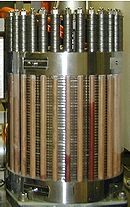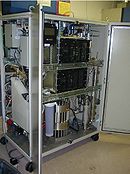
High pressure electrolysis
Encyclopedia


Electrolysis of water
Electrolysis of water is the decomposition of water into oxygen and hydrogen gas due to an electric current being passed through the water.-Principle:...
by decomposition of water (H2O) into oxygen (O2) and hydrogen
Hydrogen
Hydrogen is the chemical element with atomic number 1. It is represented by the symbol H. With an average atomic weight of , hydrogen is the lightest and most abundant chemical element, constituting roughly 75% of the Universe's chemical elemental mass. Stars in the main sequence are mainly...
gas (H2) due to the passing of an electric current through the water. The difference with a standard proton exchange membrane
Proton exchange membrane
A proton exchange membrane or polymer electrolyte membrane is a semipermeable membrane generally made from ionomers and designed to conduct protons while being impermeable to gases such as oxygen or hydrogen...
electrolyzer
Electrolysis of water
Electrolysis of water is the decomposition of water into oxygen and hydrogen gas due to an electric current being passed through the water.-Principle:...
is the compressed hydrogen
Compressed hydrogen
Compressed hydrogen is the gaseous state of the element hydrogen kept under pressure. Compressed hydrogen in hydrogen tanks at 350 bar and 700 bar is used for mobile hydrogen storage in hydrogen vehicles...
output around 120–200 Bar
Bar (unit)
The bar is a unit of pressure equal to 100 kilopascals, and roughly equal to the atmospheric pressure on Earth at sea level. Other units derived from the bar are the megabar , kilobar , decibar , centibar , and millibar...
(1740–2900 psi
Pounds per square inch
The pound per square inch or, more accurately, pound-force per square inch is a unit of pressure or of stress based on avoirdupois units...
) at 70 °C. By pressurising the hydrogen in the electrolyser the need for an external hydrogen compressor
Hydrogen compressor
A hydrogen compressor is a device that increases the pressure of hydrogen by reducing its volume. Compression of hydrogen gas naturally increases its temperature, due to Charles' Law....
is eliminated, the average energy consumption for internal differential pressure compression is around 3%.
Approaches
As the required compression power for water is less than that for hydrogen-gas the water is pumped up to a high-pressure, in the other approach differential pressure is used.Ultrahigh-pressure electrolysis
Ultrahigh-pressure electrolysis is high-pressure electrolysis operating at 5000–10000 psi. At ultra-high pressures the water solubility and cross-permeation across the membrane of H2 and O2 is affecting hydrogen purityHydrogen purity
Hydrogen purity or hydrogen quality is a term to describe the lack of impurities in hydrogen as a fuel gas. The purity requirement varies with the application, for example a H2 ICE can tolerate low hydrogen purity where a hydrogen fuel cell requires high hydrogen purity to prevent catalyst...
, modified PEMs are used to reduce cross-permeation in combination with catalytic H2/O2 recombiners to maintain H2 levels in O2 and O2 levels in H2 at values compatible with hydrogen safety
Hydrogen safety
Hydrogen safety covers the safe use and handling of hydrogen. Hydrogen poses unique challenges due to its ease of leaking, low-energy ignition, wide range of combustible fuel-air mixtures, buoyancy, and its ability to embrittle metals that must be accounted for to ensure safe operation...
requirements.
Research
The US DOEUnited States Department of Energy
The United States Department of Energy is a Cabinet-level department of the United States government concerned with the United States' policies regarding energy and safety in handling nuclear material...
believes that high-pressure electrolysis, supported by ongoing research and development, will contribute to the enabling and acceptance of technologies where hydrogen is the energy carrier between renewable energy resources and clean energy consumers.
High-pressure electrolysis is being investigated by the DOE for efficient production of hydrogen from water. The target total in 2005 is $4.75 per gge H2 at an efficiency of 64%. The total goal for the DOE in 2010 is $2.85 per gge H2 at an efficiency of 75%. As of 2005 the DOE provided a total of $1,563,882 worth of funding for research.
Mitsubishi is pursuing such technology with its High-pressure hydrogen energy generator (HHEG) project.

